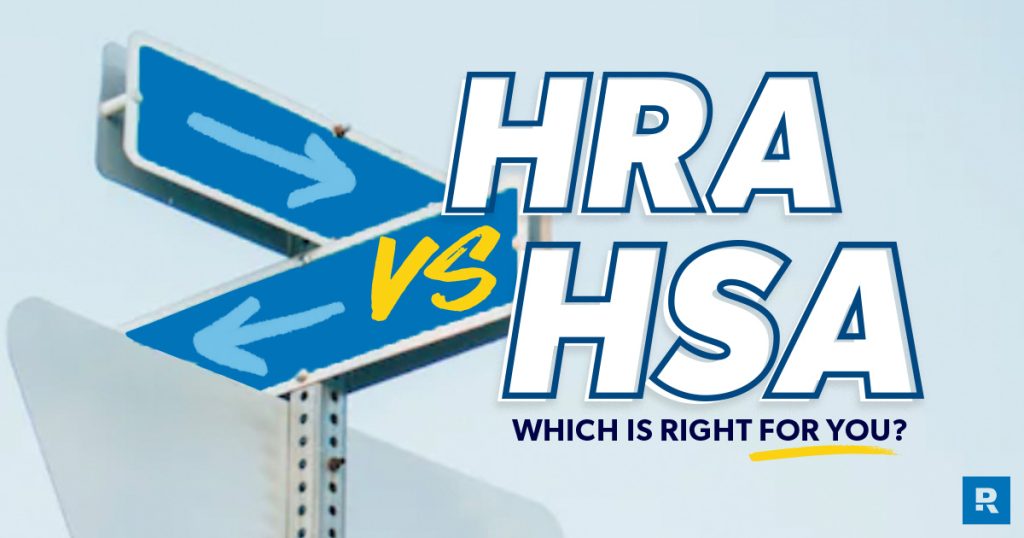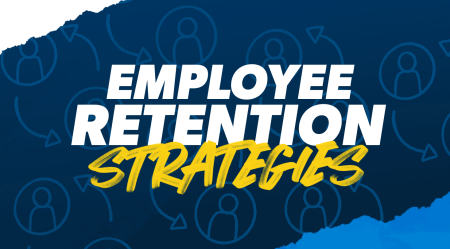Let’s face it: Navigating the ins and outs of health insurance and paying for medical expenses can be confusing and complicated. And these days, there’s yet another decision a lot of folks have to make: choosing between a health reimbursement arrangement (HRA) and a Health Savings Account (HSA).
If you’re currently in that boat, weighing HRAs vs. HSAs, don’t worry. We’re going to walk through everything you need to know so you can pick the best option for you and your family.
- HRAs (health reimbursement arrangements) and HSAs (Health Savings Accounts) are both ways to pay for qualified medical expenses.
- The money in HRAs is deposited and owned by employers, while HSA contributions are made and owned by individual account holders.
- HSA funds can earn interest and be invested just like money in a 401(k) or IRA, while HRA funds cannot.
What Is an HRA?
Health reimbursement arrangements, or HRAs, allow your employer to set their money aside for your qualified medical expenses. Basically, these are dollars your employer earmarks just for health-related expenses. Often, they work alongside a company health insurance plan—HRAs are not a replacement for insurance.
Here’s how it works: Let’s say you work for a company that offers you access to an HRA, and you go to the doctor for a sinus infection. The doctor visit costs $150, and the medicine you’re prescribed is another $30 after your insurance kicks in. You pay those costs out of pocket, but then your workplace takes $180 out of the HRA and reimburses you—assuming you haven’t already hit whatever limit they set.
The main thing to know about HRAs is that they’re employer-owned. That means if you leave your company or get let go, the money in that fund doesn’t go with you. Your employer contributed the money, so it all belongs to them.
The main thing to know about HRAs is that they’re employer-owned. That means if you leave your company or get let go, the money in that fund doesn’t go with you. Your employer contributed the money, so it all belongs to them.
How Can You Use HRA Money?
Employers can use money in an HRA to reimburse team members for their qualified medical expenses. Some examples of qualified medical expenses for an HRA include:
- Doctor visits
- Dental treatment
- Vision exams
- Glasses and contact lenses
- Prescription drugs
- Counseling
- Dermatological care1
Types of HRAs
There are several different types of HRAs, but the three most common are standard HRAs, individual coverage HRAs and excepted benefit HRAs.
Standard HRA
As the name suggests, this is the normal, cut-and-dry health reimbursement arrangement. Employers use it to save money on behalf of their team members so they can reimburse them for qualified medical expenses. There are no federal contribution limits for standard HRAs.
Individual Coverage HRA
Employers often offer an individual coverage HRA as an alternative to a traditional employer-sponsored health plan. That’s because individual coverage HRAs can be used to reimburse employees for premiums on health insurance policies they purchase on their own in addition to the qualified medical expenses listed above. Like standard HRAs, individual coverage HRAs have no federal contribution limits.
Excepted Benefit HRA
Offered alongside an employer-sponsored group health insurance plan, companies can use excepted benefit HRAs (EBHRAs) to help their team members pay for expenses not covered by their health insurance—like eye exams and dental care. They have a federal contribution limit of $2,100.2
Other types of HRAs include qualified small employer HRAs (QSEHRAs), group coverage HRAs, and retirement HRAs, which we’ll go over later.
Advantages of an HRA
- HRAs are entirely funded by your employer. All HRA contributions are made by employers on behalf of their team members. The average annual employer contribution for HRAs is $1,815 for single coverage and $3,322 for family coverage.3
- The money in HRAs can be used for all kinds of medical expenses. Like we saw earlier, visits to the doctor aren’t the only thing you can spend HRA funds on. Vision exams, dental care, glasses, contact lenses and counseling are also on the list of HRA-qualified medical expenses.4
- Some HRA types can be used to reimburse your health insurance premiums. The same is not true for HSAs.
What Is an HSA?
HSA stands for Health Savings Account, and it’s exactly what it sounds like: an account where you can put money to save for health expenses. Unlike an HRA, which is owned and funded by your employer, you own and fund an HSA.
HSAs are a great way to save for medical expenses because they come with big-time tax benefits. Not only are your contributions tax deductible going in, but they also grow tax-free when you invest them. And to top it all off, you aren’t taxed when you withdraw money from your HSA to pay for qualified medical expenses.
You have to meet some eligibility requirements before opening an HSA—the most important is that you’re enrolled in a high-deductible health plan (HDHP), which is a health insurance policy that requires you to pay more of your health care expenses out of pocket before the policy begins covering them. If you don’t have an HDHP, you can’t have an HSA.
How Can You Use HSA Money?
HSA money can be used for the same list of qualified medical expenses as HRA funds, like glasses, contacts, and visits to doctors, dentists and optometrists.5
Advantages of an HSA
- The money you contribute is tax-free. That’s right: You don’t have to pay taxes on money you put into an HSA. If your HSA is set up through your workplace, they can even deduct your contributions directly from your paycheck pretax. Like an HRA, you also don’t have to pay taxes on HSA funds when you withdraw them to use for qualified medical expenses (including dental and vision).
- HSA funds collect interest, and they can be invested. You’ll automatically collect interest on your HSA contributions, but you can also invest HSA funds just like with a 401(k) or IRA.
- You own the funds in your HSA, not your employer. Because HSAs belong to individuals instead of employers, the funds inside are yours to keep if you decide to change jobs.
Get the health insurance you need from Health Trust Financial today!
When RamseyTrusted partner Health Trust Financial is in your corner, you’ll have peace of mind knowing you have the right health insurance that won’t break the bank.
Connect With Health Trust Financial
5 Differences Between an HRA and an HSA
Both HRAs and HSAs are designed to give you more control of the money you spend on your health care, and they’re both intended to be used for qualified medical expenses. But that’s about where the similarities end. So, let’s look at the differences between HRAs vs. HSAs.
1. Ownership
This is the biggest difference between an HRA and an HSA: You own your HSA, but an employer owns your HRA. As we said above, if you have an HRA and change jobs or get let go, those funds don’t leave with you. They belong to your employer, and you won’t have access to them. But if you open an HSA—whether through your employer or on your own—that HSA belongs to you no matter what happens with your job.
2. Eligibility
You can only access an HRA through your employer. Individual HRAs may be open to all employees, or your employer might only offer them to certain classes of employees, like salaried employees but not hourly workers.
You can open an HSA through an employer or on your own. Whether you open an HSA through work or independently, the same eligibility requirements stand. And the main one is that you’re enrolled in a high-deductible health plan. If you’re self-employed, don’t work, or your employer doesn’t offer an HSA-eligible plan, you can open one on your own.
3. Tax Benefits
When it comes to HRAs, the tax benefit is for the employer. Though you won’t be taxed on the money you get from an HRA, your employer will be the one benefiting from that since it’s their money.
HSAs, however, are triple tax-advantaged for you. If your HSA is through your employer, your contributions can come straight out of your paycheck and into your HSA without counting as income. That’s called a pretax payroll deduction. Or depending on your situation, you can also claim your contributions as tax deductions when you file your tax return.
Not only do your contributions go in tax-free, but they also grow tax-free. And as long as you use your HSA money for qualified medical expenses, then you don’t get hit with any taxes or penalties when you withdraw funds. Cha-ching!
4. Contribution Limits
The type of HRA your company offers will determine how much your employer can contribute. Certain types of HRAs have no contribution limits, and others do.
HSA contribution limits are more straightforward. In 2023, you can contribute up to $3,850 per year for single coverage or $7,750 for family coverage.6 If your employer contributes to your HSA, those limits include their contribution as well. (Keep that in mind so you don’t over-contribute and get dinged with a penalty.)
5. Investments
Since HRA funds belong to your employer, you can’t invest them. But with an HSA, you can invest your contributions. Not only will they earn interest just sitting in your HSA, but you can also invest them in mutual funds.
Most HSA providers will require you to have a balance of $1,000 before you can invest. You’ll want to treat this investment the same way you would a 401(k) or IRA, by investing in good growth stock mutual funds with a long-term history of strong returns.
Pros and Cons: HRA vs. HSA
The best way to break down the pros and cons of HRAs and HSAs is to look at what each type of program does and doesn’t have to offer. Here’s a handy chart so you can compare your options and decide which is best for you!
|
HSA |
HRA |
|
|
Employers Can Contribute Money |
✓ |
✓ |
|
You Can Contribute Money |
✓ |
X |
|
Funds Can Grow and Be Invested |
✓ |
X |
|
High-Deductible Health Plan (HDHP) Required |
✓ |
X |
|
Can Be Used on Dental and Vision |
✓ |
✓ |
|
Funds Go With You After a Job Change |
✓ |
X |
|
Can Be Used on Insurance Premiums |
X |
✓ |
Average Employer HSA and HRA Contributions for Single Coverage
All the money in HRAs is contributed by employers. And in a lot of cases, they’re fairly generous. The average annual employer contribution for HRAs is $1,815 for single coverage and $3,322 for family coverage.7
Even though HSAs are owned by individuals, sometimes employers will offer HSA contributions as a benefit to their team. In fact, over a fourth of all money deposited into HSAs in 2022 came from employers.8 The average HSA employer contribution in 2022 was $869.9
Can You Have an HRA and an HSA?
You may be wondering whether it’s possible to have an HRA and an HSA. The answer? It depends. It is possible to have access to an HSA at the same time as an HRA, but only with certain types of HRAs.
The types of HRAs that can be used at the same time as an HSA are:
- Limited Purpose HRA: These pay for limited medical expenses, determined by your employer. Money withdrawn from a limited purpose HRA doesn’t count toward your deductible.
- Post-Deductible HRA: As the name suggests, these only cover qualified medical expenses that go beyond your health insurance deductible.
- Retirement HRA: This is a type of HRA offered by employers to retirees as an extra benefit.
- Suspended HRA: If your employer enrolls you in an HRA and you suspend it, you’ll be eligible for an HSA as long as the HRA is suspended.
HRA vs. HSA: Which Is Right for You?
In general, an HSA is a better option than an HRA. That’s because, as we’ve talked about, HSAs give you a lot more control by letting you be the one saving money for your medical expenses instead of your employer.
But there definitely are situations when you may want to go with an HRA instead of an HSA. For example, you may work for a small business that offers an HRA as a substitution for a group insurance plan with an HSA. Or your company’s health insurance plan may not include an HDHP, in which case you wouldn’t be eligible for an HSA.
If you need help deciding which option is the better choice for you, don’t make any major decisions without talking to an experienced insurance professional. The best way to get connected with one is through our RamseyTrusted friends at Health Trust Financial.
The health insurance experts at Health Trust Financial are independent agents with the heart of a teacher. They’ll walk you through all your options and help you make the right choice when it comes to HRAs vs. HSAs.
Frequently Asked Questions
-
Can I take money out of an HRA for nonmedical expenses?
-
No, HRA funds can only be used for qualified medical expenses, like visits to a medical doctor, dentist or eye doctor.
-
How much money can I put into an HSA and HRA?
-
In 2023, the HSA annual contribution limits are $3,850 for single coverage and $7,750 for family coverage.10 While you can’t put money into an HRA yourself, your employer can. And HRA contribution limits depend on the type of HRA your employer uses. Some types, like an individual coverage HRA, have no contribution limits. Others, like a qualified small employer HRA (QSEHRA), do have limits. QSEHRAs have limits of $5,850 for single coverage or $11,800 for families.11
-
Can you take an HRA with you if you change jobs?
-
No, you cannot take HRA funds with you if you change jobs. The arrangement and the money inside it belong to your employer.
-
Can you use HRA and HSA funds to pay for dental care?
-
Yes! Dental care is considered a qualified medical expense for both HRAs and HSAs.
-
What is an FSA?
-
An FSA is a flexible spending account where you can save pretax dollars to use on qualified medical expenses. FSAs are similar to HSAs, but there are some differences. FSAs have smaller contribution limits than HSAs, and any funds you put in expire at the end of the calendar year.
Did you find this article helpful? Share it!
Read the full article here












